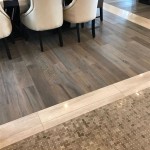Installing vinyl plank flooring is an easy and affordable way to update any space. But what happens when it comes to changing the direction of the planks between rooms? It’s a common question that homeowners have, and there are a few different ways to approach the situation. In this article, we’ll discuss the different ways to change the direction of vinyl plank flooring between rooms, as well as the pros and cons of each approach.
Why Change The Direction Of Vinyl Plank Flooring Between Rooms?
There are a few reasons why you might want to change the direction of vinyl plank flooring between rooms. For one, it can create visual interest. By changing the direction of the planks, you create a unique look that can make the space look larger and more inviting. Additionally, changing the direction of the planks can help reduce the appearance of traffic patterns, as the planks in different directions can help to break up the straight lines of traffic.
Options For Changing Direction Of Vinyl Plank Flooring
When it comes to changing the direction of vinyl plank flooring between rooms, there are a few different options. One is to use a transition strip, which is a piece of trim that covers the seam between two floors of different directions. Transition strips come in a variety of materials and colors, so you can find one that matches the look of your vinyl plank flooring. You can also opt for a T-molding, which is a similar piece of trim that covers the seam between two floors of different heights. Finally, you can also use an inside corner, which is a piece of trim that covers the corner between two walls.
Pros & Cons Of Changing Direction Of Vinyl Plank Flooring
Changing the direction of the vinyl plank flooring between rooms can create a unique and attractive look. However, there are also some drawbacks to consider. One is that changing the direction of the planks can be more time consuming and difficult than installing planks in a single direction. Additionally, transitioning between two different directions can be more difficult and require more precise measurement and cutting. Finally, if you’re working with an existing floor, it can be difficult to match the plank direction with that of the existing floor.
How To Change Direction Of Vinyl Plank Flooring
If you decide to change the direction of vinyl planking between rooms, the first step is to measure the space accurately. Measure the length and width of the room, as well as the dimensions of the doorways and other objects that may affect the plank direction. Once you have the measurements, you can determine the direction of the planks and make any necessary cuts. You’ll also need to consider the type of transition strips or T-moldings that you’ll need to cover the seams.
Conclusion
Changing the direction of vinyl plank flooring between rooms is a great way to create a unique look and reduce the appearance of traffic patterns. However, it can be time consuming and difficult to do properly, so it’s important to measure the space accurately and use the right materials to cover the seams. With the right preparation and the right materials, you can successfully change the direction of your vinyl plank flooring between rooms.















Related Posts








